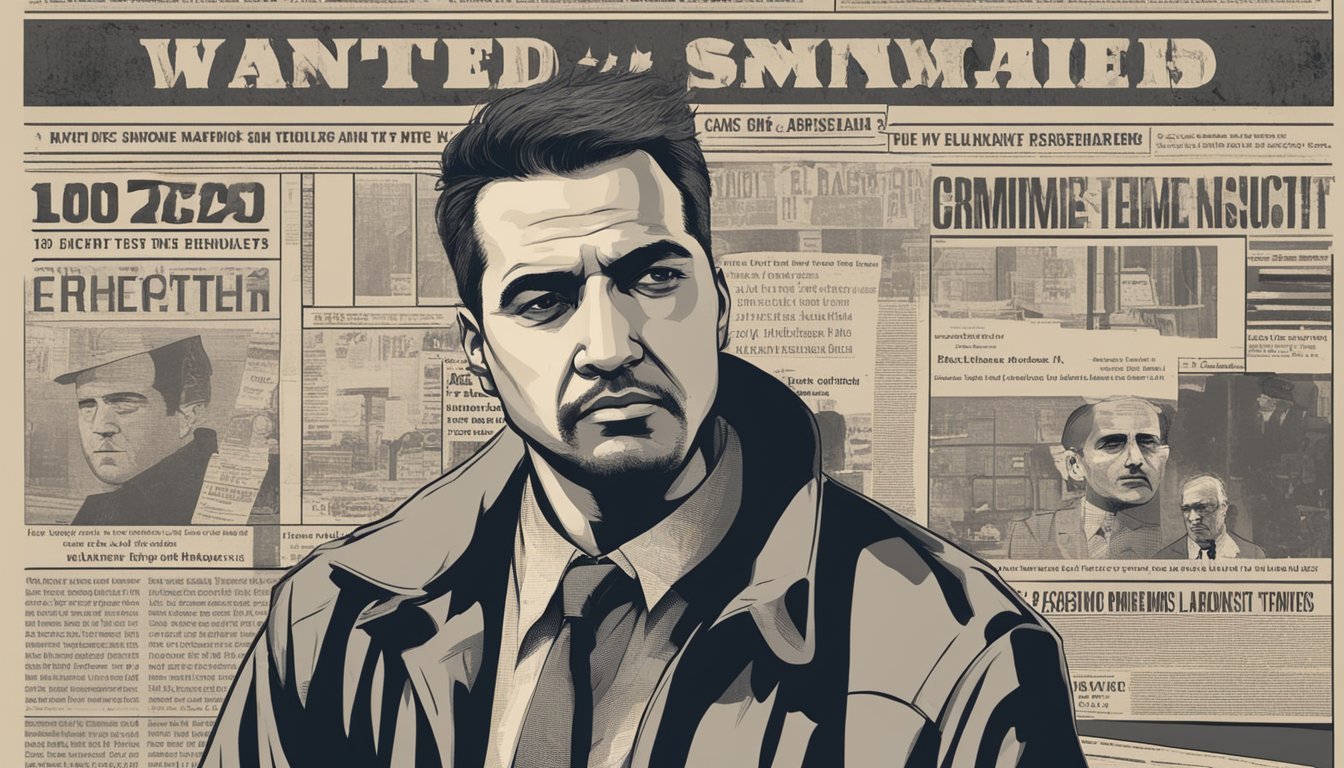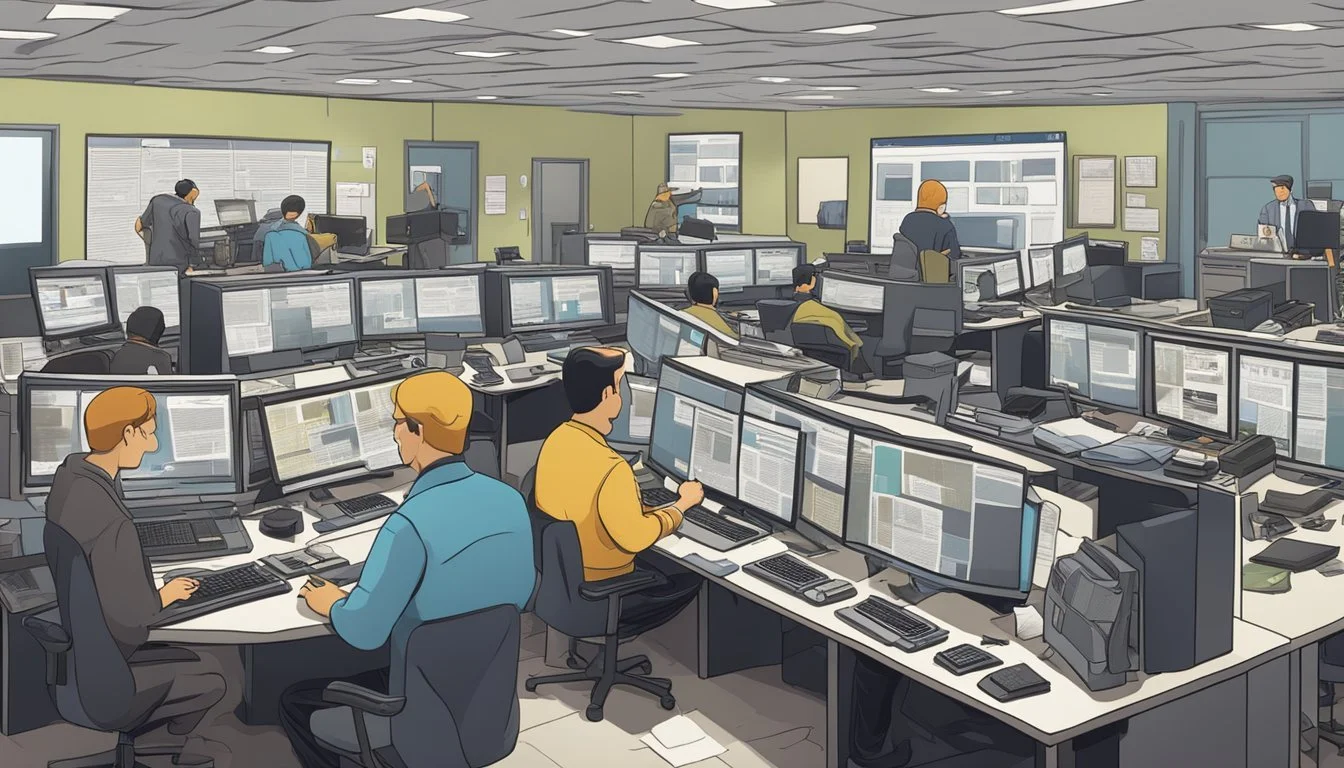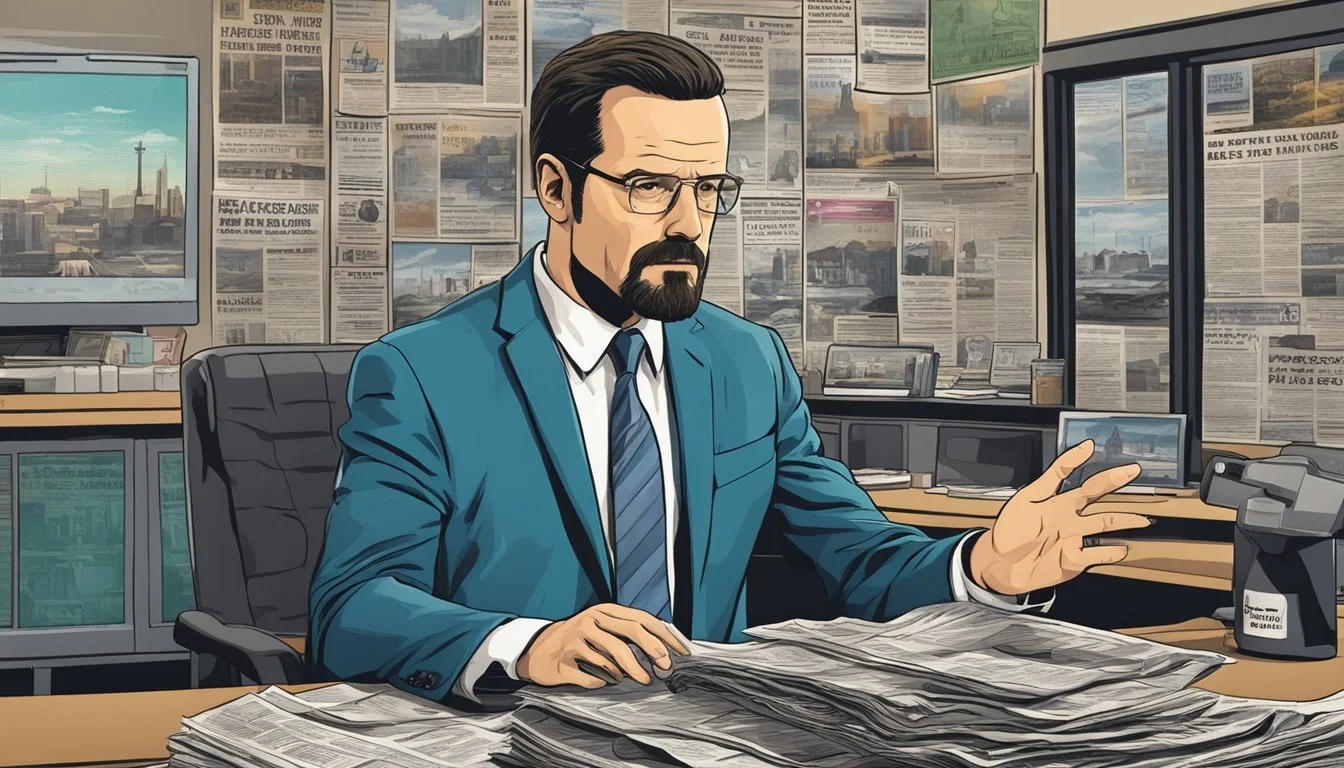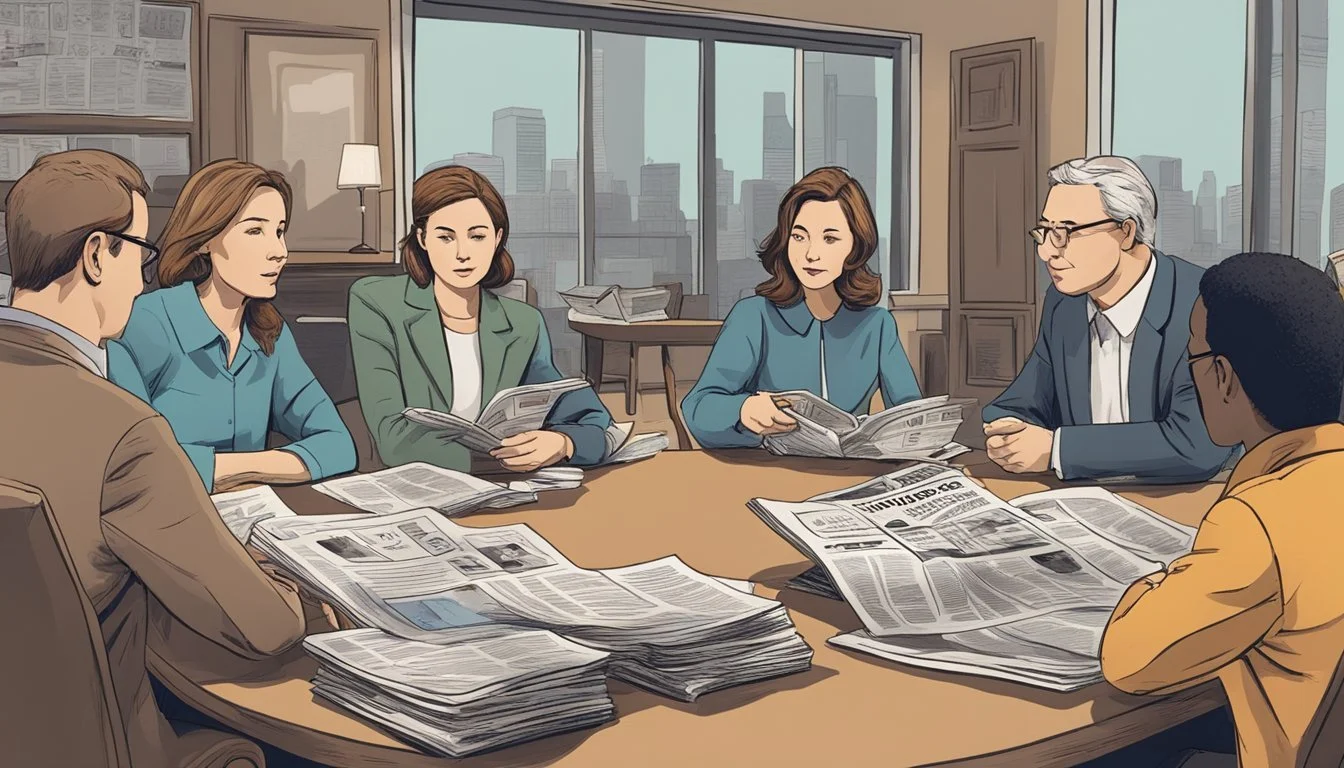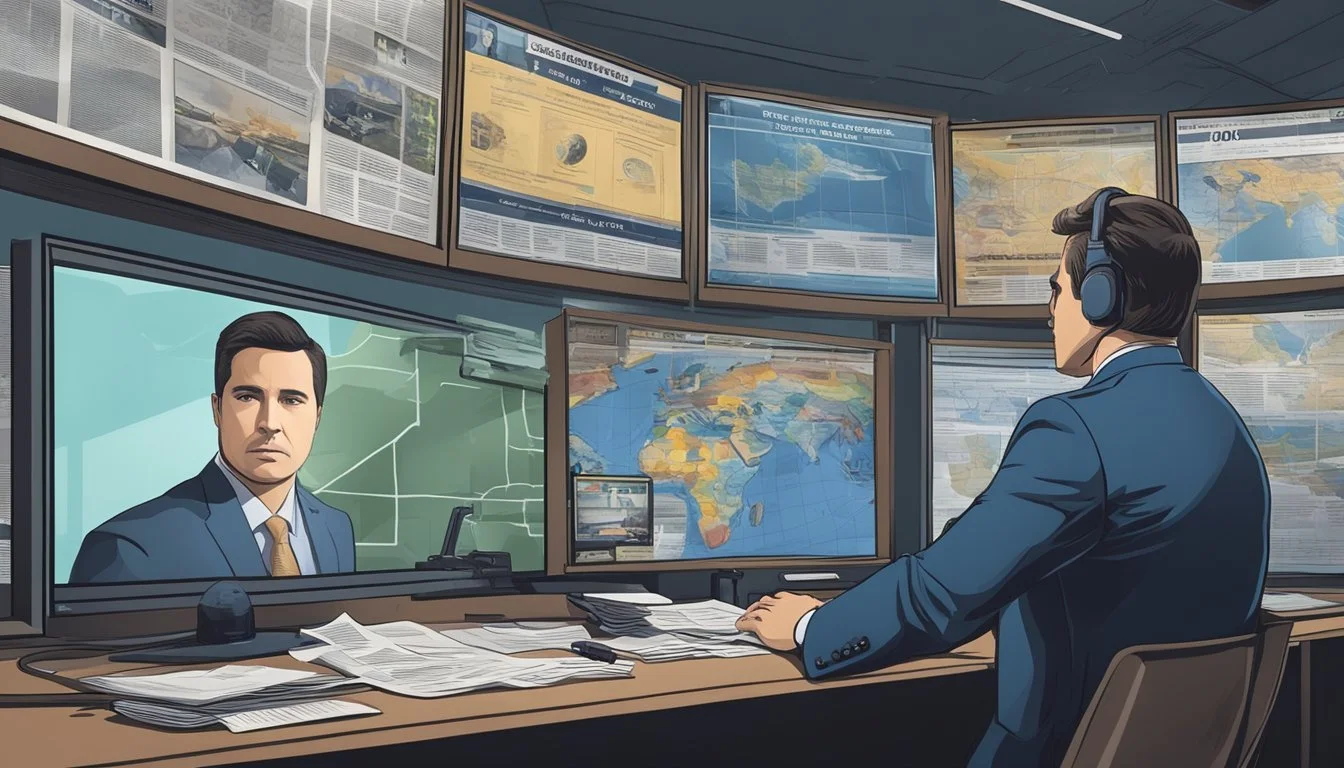Breaking Bad's Portrayal of the Media's Role in Crime
A Critical Analysis of News Coverage in the Series
Breaking Bad, the critically acclaimed AMC series created by Vince Gilligan, offers a nuanced portrayal of the media's role in crime. The show follows Walter White's transformation from a high school chemistry teacher to a methamphetamine kingpin in Albuquerque, New Mexico. Throughout its five-season run, Breaking Bad explores how media coverage impacts criminal activities and public perception.
The series demonstrates how news outlets can inadvertently glorify criminal behavior, turning figures like Walter White into anti-heroes. This portrayal raises questions about the ethics of media sensationalism and its potential to influence public opinion. Breaking Bad also showcases how criminals manipulate media coverage to their advantage, using it as a tool for misdirection or to spread fear among rivals.
The show's depiction of media involvement in criminal investigations adds another layer of complexity. It highlights the delicate balance between the public's right to information and the need for law enforcement to maintain operational secrecy. Through these various angles, Breaking Bad provides a thought-provoking examination of the intricate relationship between media and crime in modern society.
The Genesis of 'Breaking Bad'
'Breaking Bad' emerged from a simple yet captivating premise, evolving into a groundbreaking television series. Its creation involved key figures and decisions that shaped its unique identity.
Vince Gilligan and the Conceptualization
Vince Gilligan, the mastermind behind 'Breaking Bad', conceived the show's premise during a conversation with a friend. The idea of a law-abiding citizen turning to crime struck Gilligan as a compelling narrative. He envisioned a character transformation from "Mr. Chips to Scarface."
Gilligan drew inspiration from his own experiences and observations of middle-class struggles. He crafted a story that would explore the moral decay of its protagonist, setting it against the backdrop of Albuquerque, New Mexico.
The concept of a high school chemistry teacher turning to drug manufacturing provided a unique angle. It allowed for the exploration of scientific elements within the crime drama genre.
Casting Walter White and Jesse Pinkman
Bryan Cranston's casting as Walter White was pivotal to the show's success. Gilligan had worked with Cranston on 'The X-Files' and recognized his ability to portray both vulnerability and menace.
AMC initially hesitated to cast Cranston, known primarily for his comedic role in 'Malcolm in the Middle'. Gilligan's insistence on Cranston's versatility ultimately won over the network.
Aaron Paul secured the role of Jesse Pinkman after impressing in his audition. The character, originally slated for elimination in the first season, became integral to the show's dynamic due to Paul's performance.
AMC's Role in the Series Creation
AMC took a significant risk in greenlighting 'Breaking Bad'. The network was relatively new to original programming and sought bold content to establish its brand.
The network provided Gilligan with creative freedom, allowing him to explore dark themes and complex characters. This trust in Gilligan's vision was crucial in shaping the show's unique tone and style.
AMC's commitment to quality over immediate ratings success gave 'Breaking Bad' time to build its audience. The network's patience allowed the show to develop into a cultural phenomenon.
Breaking Bad's Narrative Structure
Breaking Bad employs innovative storytelling techniques, strategic use of flashbacks, and masterful character development to create a compelling serialized drama. These elements combine to form a unique narrative structure that captivates audiences.
Storytelling Techniques
Breaking Bad's narrative structure relies on a "slow burn" approach. Tension builds gradually, allowing viewers to witness Walter White's transformation in an organic yet unsettling manner. The show uses color symbolism to enhance its storytelling. Green represents greed and envy, while yellow signifies caution and moral corruption.
Each episode builds upon the last, creating a cohesive narrative arc. The series utilizes cliffhangers and plot twists to maintain suspense and keep viewers engaged. Breaking Bad also employs visual metaphors and foreshadowing to add depth to its storytelling.
Utilizing Flashbacks
Flashbacks play a crucial role in Breaking Bad's narrative structure. These scenes provide essential backstory and context for characters' motivations and actions. The show often uses flashbacks to reveal pivotal moments from the past that inform present events.
These retrospective scenes are strategically placed to create dramatic irony and enhance the viewer's understanding of the characters' journeys. Flashbacks in Breaking Bad are not mere exposition but serve to deepen the emotional impact of current storylines.
Character Development Through Serialized Drama
Breaking Bad's serialized format allows for intricate character arcs that unfold over multiple seasons. Characters evolve in response to the plot's challenges and their own choices. Walter White's transformation from a mild-mannered teacher to a ruthless drug lord is a prime example of this gradual development.
The show explores the complexities of its characters through their relationships, moral dilemmas, and personal struggles. Supporting characters also undergo significant growth, adding depth to the narrative. This approach to character development creates a rich, multi-layered story that keeps viewers invested in the characters' fates.
Media Representation in Breaking Bad
Breaking Bad offers a multifaceted portrayal of media's role in crime. The show examines how television shapes perceptions of the drug trade, explores moral complexities through family dynamics, and depicts the influence of news media on criminal activities.
Television's Portrayal of the Drug Trade
Breaking Bad presents a nuanced depiction of the drug trade, challenging stereotypical portrayals often seen in mainstream media. The series showcases the intricate operations of methamphetamine production and distribution.
Walter White's transformation from a high school chemistry teacher to a drug kingpin highlights the blurred lines between law-abiding citizens and criminals. This portrayal encourages viewers to question their preconceptions about who participates in the drug trade.
The show also explores the economic motivations behind drug-related crimes, presenting a more complex picture than typical "good vs. evil" narratives. By humanizing characters involved in illegal activities, Breaking Bad prompts audiences to consider the socioeconomic factors that can lead to criminal behavior.
The Depiction of Morality and Family
Breaking Bad uses family dynamics to explore moral dilemmas and the consequences of criminal actions. Walter White's initial motivation to provide for his family after his cancer diagnosis serves as a catalyst for his descent into the drug trade.
The show portrays the strain that criminal activities place on familial relationships. Skyler White's evolution from an oblivious wife to an unwilling accomplice illustrates the corrosive effect of secrets and illegal activities on family bonds.
Through Jesse Pinkman's troubled relationship with his parents, the series examines how societal expectations and family disappointment can contribute to a person's involvement in crime. These complex family portrayals challenge viewers to consider the gray areas of morality in difficult circumstances.
The Role of News Media within the Show
Breaking Bad incorporates news media as a crucial element in shaping public perception of criminal activities. News reports and television coverage play a significant role in disseminating information about drug-related crimes and law enforcement efforts.
The series depicts how media coverage can inadvertently glorify criminal activities, as seen in the public fascination with the mysterious "Heisenberg." This portrayal highlights the media's potential to create anti-heroes and influence public opinion.
Breaking Bad also explores how criminals manipulate media coverage to their advantage. Walter White's carefully orchestrated video confession demonstrates the power of controlling one's narrative in the media landscape. This aspect of the show prompts viewers to critically evaluate the information presented by news outlets and consider potential biases or manipulations.
Cultural Impact
Breaking Bad's portrayal of media in crime storylines profoundly influenced television and popular culture. The show's approach to depicting media involvement in criminal activities set new standards for storytelling and audience engagement.
Influence on Popular Culture
Breaking Bad's portrayal of media in crime narratives resonated deeply with viewers. The show's depiction of news coverage and social media reactions to Walter White's activities became a cultural touchstone. Memes, catchphrases, and iconic scenes from the series spread rapidly online, cementing its place in pop culture discourse.
The blue crystal meth motif became instantly recognizable, appearing on merchandise and in countless references across various media. Breaking Bad's impact extended to fashion, with Heisenberg-style pork pie hats and yellow hazmat suits becoming popular Halloween costumes.
Comparative Analysis with Other Crime Shows
Breaking Bad's treatment of media differed significantly from predecessors like The Wire and The Sopranos. While those shows often portrayed media as peripheral or manipulated by criminals, Breaking Bad integrated news coverage as a central plot device.
The Wire focused on institutional failures, including those of the press. The Sopranos occasionally touched on media influence but didn't make it a core theme. Breaking Bad, in contrast, showed how media attention could both hinder and inadvertently assist criminal enterprises.
This unique approach influenced subsequent crime dramas, encouraging more nuanced portrayals of media's role in criminal narratives.
Breaking Bad and the 'Netflix Effect'
Breaking Bad benefited significantly from the rise of streaming platforms, particularly Netflix. The show's availability on Netflix allowed new viewers to discover and binge-watch earlier seasons, boosting its popularity and cultural impact.
This phenomenon, dubbed the "Netflix Effect," demonstrated how streaming services could revitalize and expand audiences for TV shows. Breaking Bad's success on Netflix influenced how networks and streaming platforms approach content distribution and audience engagement.
The show's popularity on Netflix also contributed to the platform's decision to invest heavily in original content, paving the way for a new era of high-quality streaming television.
Technical Aspects of Breaking Bad
Breaking Bad's technical execution elevated the show's storytelling. Innovative cinematography, immersive sound design, and deliberate editing created a visceral viewing experience that matched the intensity of the plot.
Cinematography and Visual Storytelling
Breaking Bad's cinematography set new standards for television. The show utilized wide-angle lenses to capture the vast New Mexico landscapes, contrasting them with claustrophobic interiors. Time-lapse sequences depicted the passage of time and the frenetic pace of drug production.
Distinctive color palettes differentiated story arcs and character development. Walter White's transformation was reflected in his wardrobe, shifting from beige to darker tones. The infamous yellow hazmat suits became iconic visual elements.
POV shots from inanimate objects, like the lab equipment or a roomba, added unique perspectives. These creative choices immersed viewers in the world of the characters and enhanced the narrative's impact.
Music and Sound Design
The show's audio landscape was meticulously crafted to heighten tension and emotion. The opening theme, a short guitar riff with percussion, set an ominous tone for each episode.
Composer Dave Porter created a score that blended Southwestern influences with electronic elements, mirroring the clash between tradition and modernity in the story.
Sound design played a crucial role in building atmosphere. The buzzing of flies, the clinking of lab equipment, and the rumble of car engines became auditory motifs. Silence was used strategically to amplify dramatic moments.
Editing and Pace
Breaking Bad's editing style contributed significantly to its narrative power. The show employed a mix of long takes and rapid cuts to control pacing and build suspense.
Montages were used effectively to compress time and showcase the repetitive nature of drug production. These sequences often featured upbeat music, creating a jarring contrast with the illegal activities depicted.
The cold opens, often cryptic or seemingly unrelated to the main plot, became a hallmark of the series. These teasers hooked viewers and set up thematic elements for each episode.
Jump cuts and match cuts linked scenes visually, creating a sense of continuity and thematic connections across storylines.
Viewer Reception and Critique
Breaking Bad garnered widespread acclaim from critics and audiences alike, sparking intense discussions across various platforms. The show's complex portrayal of crime and morality resonated deeply with viewers, leading to numerous accolades and a devoted fan base.
Critical Acclaim and Awards
Breaking Bad received universal praise for its storytelling, character development, and performances. The series won 16 Primetime Emmy Awards, including four for Outstanding Drama Series. Bryan Cranston and Aaron Paul earned multiple acting Emmys for their roles as Walter White and Jesse Pinkman.
Critics lauded the show's nuanced exploration of moral ambiguity and its unflinching portrayal of the consequences of criminal actions. Many reviewers highlighted the series' ability to maintain tension and surprise viewers throughout its run.
AMC's bold programming choice was vindicated by Breaking Bad's success, cementing the network's reputation for high-quality original content.
Fan Engagement and Community
Breaking Bad's fanbase grew exponentially as the series progressed. Online forums, social media platforms, and fan sites buzzed with theories, analysis, and discussions about each episode.
Podcasts dedicated to Breaking Bad emerged, offering in-depth commentary and behind-the-scenes insights. These platforms fostered a sense of community among viewers, allowing them to share their interpretations and reactions.
Fan art, cosplay, and memes became prevalent, demonstrating the show's cultural impact. Breaking Bad-themed merchandise and experiences, such as pop-up bars and interactive exhibits, further engaged the fan community.
Impact on Viewer Perception of Crime
Breaking Bad challenged viewers' preconceptions about crime and morality. The series depicted the gradual corruption of its protagonist, prompting audiences to question their own ethical boundaries.
Some parents and educators expressed concerns about the show's portrayal of drug manufacturing and violence. Common Sense Media and parent reviews often cautioned about the mature content while acknowledging the series' artistic merit.
Articles and academic studies examined Breaking Bad's influence on public perceptions of the methamphetamine trade and the criminal justice system. The show sparked debates about the humanization of criminals and the blurred lines between right and wrong in extreme circumstances.
Moral and Educational Discussions
Breaking Bad sparks intense debates about morality and educational value. The show's complex portrayal of ethics and societal issues offers rich material for analysis and discussion.
The Show's Approach to Morality
Breaking Bad presents a nuanced exploration of moral decay. Walter White's transformation from a sympathetic protagonist to an antihero challenges viewers' ethical frameworks. The series portrays characters making difficult choices in morally gray areas, often blurring the lines between right and wrong.
Drug addiction is depicted as a destructive force, affecting both users and their families. The show doesn't glamorize drug use, instead showcasing its devastating consequences.
Characters face ethical dilemmas that prompt viewers to question their own moral boundaries. This approach encourages critical thinking about complex societal issues.
Educational Value in Breaking Bad
Breaking Bad offers educational value beyond its entertainment factor. The show's detailed portrayal of chemistry in methamphetamine production has sparked interest in science among viewers.
It provides insights into the drug trade, law enforcement, and the criminal justice system. These elements can serve as starting points for discussions on social issues and policy.
The series also explores themes of identity, family dynamics, and the impact of terminal illness. These topics can be used in educational settings to analyze character motivations and societal pressures.
Parental Guidance and Age Appropriateness
Common Sense Media rates Breaking Bad as appropriate for ages 17+. The show's intense content, including violence and drug use, requires mature viewers.
Parent reviews often emphasize the need for adult guidance when younger viewers watch the series. Many suggest that age 14+ might be appropriate with proper context and discussion.
The show's complex themes and moral ambiguity make it valuable for family discussions about ethics and consequences. However, parents should be prepared to address the show's graphic content and challenging subject matter.
Breaking Bad's educational potential must be balanced with its mature themes. Viewer discretion and parental involvement are crucial for younger audiences.
Content Warnings and Viewer Discretion
Breaking Bad tackles mature themes through graphic content and complex characters. The show's creators implemented various content warnings and discretion measures to alert viewers to potentially disturbing material.
Depiction of Violence and Drug Use
Breaking Bad portrays brutal violence and extensive drug use throughout its run. Scenes depict graphic injuries, murders, and corpse disposal. Drug manufacturing and usage are shown in detail, including the effects of methamphetamine addiction.
The series doesn't shy away from portraying the harsh realities of the criminal underworld. Gunfights, explosions, and physical altercations occur frequently. Characters suffer severe injuries and deaths on screen.
Drug-related content includes cooking meth, using various substances, and showing the physical and mental toll of addiction. These elements are integral to the plot but may be disturbing to some viewers.
Sexual Content and Language
While not the show's primary focus, Breaking Bad contains sexual content and strong language. Sexual situations are depicted, though rarely explicit. Nudity is limited but present in certain scenes.
The dialogue includes frequent profanity and crude language, reflecting the criminal world portrayed. Characters use strong expletives regularly, particularly in tense or violent situations.
Sexual themes are explored through relationships and occasional references to prostitution. However, these elements are generally less prominent than the violence and drug content.
Viewer Discretion Advised
AMC, the network airing Breaking Bad, consistently used a TV-MA rating for the series. This rating indicates content suitable only for mature audiences due to intense violence, sexual situations, and drug use.
Content warnings appeared before each episode, alerting viewers to specific mature elements. These warnings allowed audiences to make informed decisions about viewing the show.
Parents and guardians were advised to use caution when allowing teenagers to watch Breaking Bad. The series' complex themes and graphic content may be inappropriate for younger viewers, even with supervision.
Breaking Bad's Legacy
Breaking Bad transformed television storytelling and left an enduring impact on popular culture. Its influence continues to resonate years after its finale.
Influence on Modern Television
Breaking Bad revolutionized serialized dramas with its meticulous character development and narrative complexity. The show's success paved the way for more ambitious, cinematic television productions. Its exploration of morally ambiguous characters like Walter White and Gus Fring set a new standard for antihero-driven stories.
The series elevated visual storytelling on television, with striking cinematography and symbolic imagery becoming hallmarks. Its bold narrative choices, like killing off major characters, raised the stakes for serialized storytelling.
Breaking Bad's critical and commercial success encouraged networks to take more risks with unconventional concepts and darker themes. This shift opened doors for shows like The Walking Dead to find mainstream success.
Spin-Offs and Continuations
The Breaking Bad universe expanded through successful spin-offs. Better Call Saul delved into the backstory of fan-favorite character Saul Goodman, matching its predecessor's critical acclaim. The show explored the legal world of Albuquerque with the same attention to detail and character development.
El Camino: A Breaking Bad Movie provided closure for Jesse Pinkman's story, demonstrating the franchise's ongoing appeal. These expansions proved the depth and versatility of the Breaking Bad world.
The success of these spin-offs inspired other TV franchises to explore character-focused expansions, rather than direct sequels.
Enduring Popularity and Relevance
Breaking Bad's popularity has endured well beyond its original run. The show continues to attract new viewers through streaming platforms, introducing Walter White's transformation to new generations.
Its themes of power, morality, and the American Dream remain relevant, sparking ongoing discussions and analysis. The series' attention to detail rewards repeated viewings, with fans continually discovering new layers and foreshadowing.
Breaking Bad's influence extends to popular culture, with references appearing in other media and "Heisenberg" becoming a recognizable icon. The show's legacy as a pinnacle of television storytelling remains secure, setting a benchmark for quality drama.



